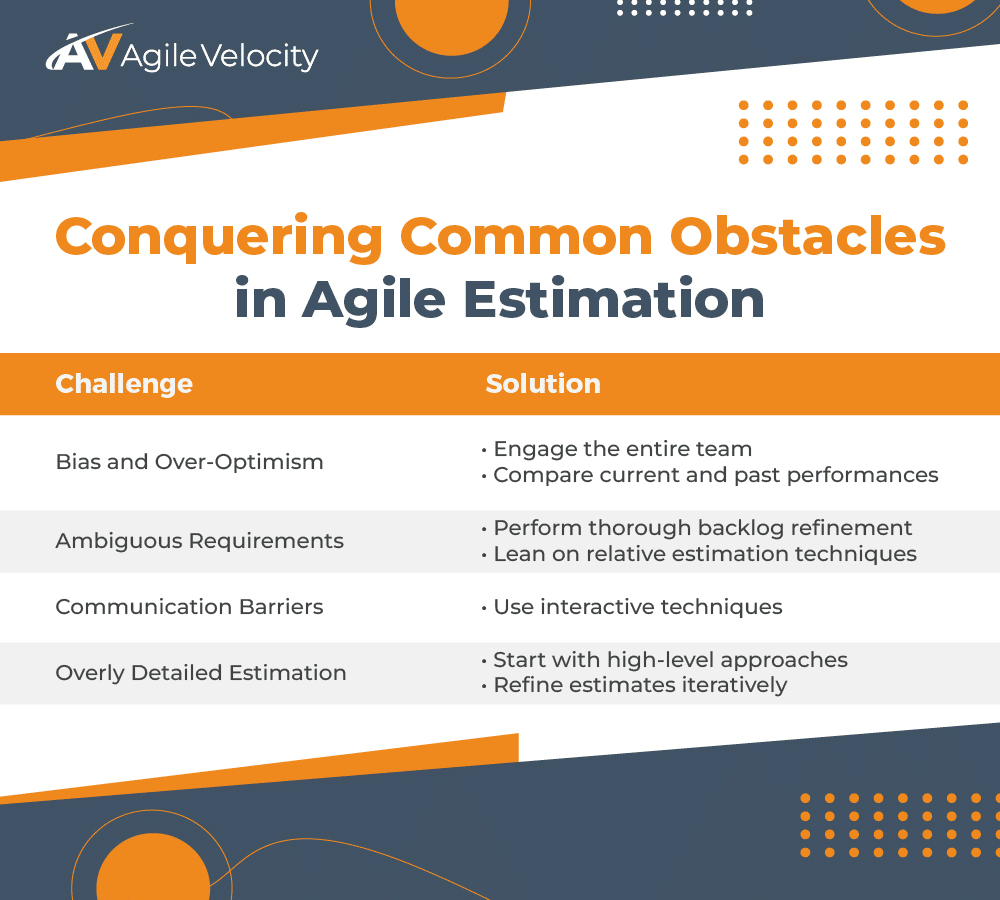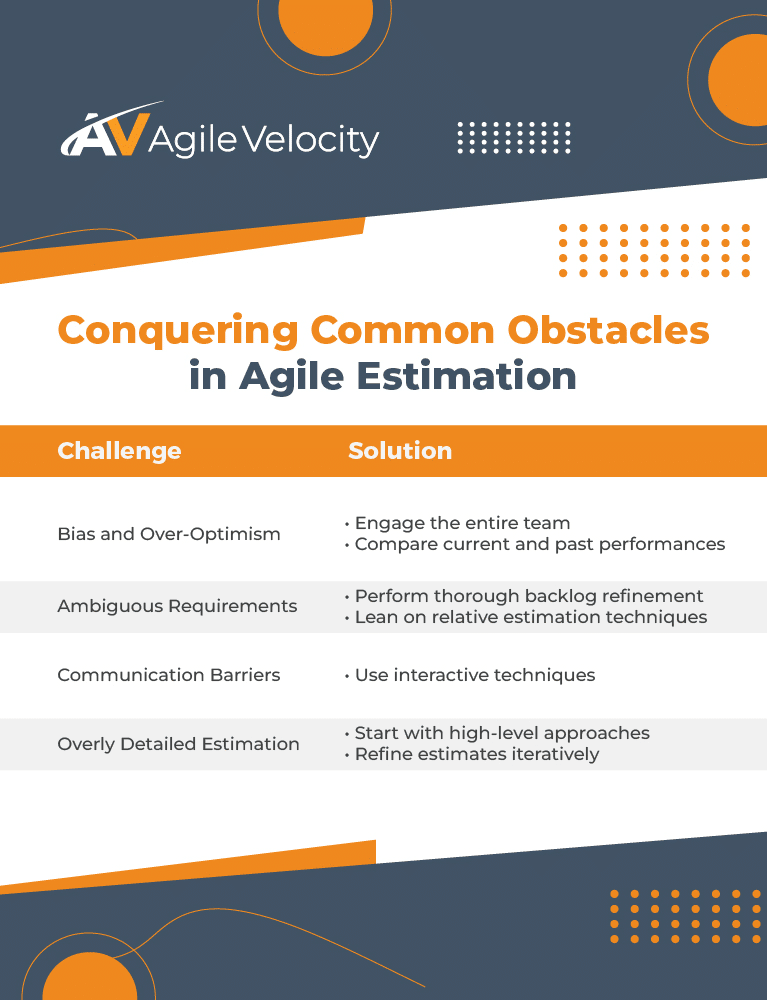Accurate estimation is one of the key challenges faced by Agile teams. It’s more than just guessing task duration—it builds alignment, enhances collaboration, and helps teams prioritize and deliver value consistently. In Agile, estimation impacts planning, risk management, and overall delivery, making it an essential aspect of any Agile Transformation.
This article explores twelve practical Agile estimation techniques that work across frameworks like Scrum, Kanban, and SAFe®. You’ll discover actionable advice on selecting the right method for your team’s context and learn how tools like Path to Agility® Navigator can support effective estimation practices.
By the end, you’ll understand why robust estimation is crucial for building realistic expectations, fostering continuous improvement, and driving more responsive delivery.
Why Accurate Estimation Is Crucial for Agile Teams
Accurate estimation isn’t about precision but about building a shared understanding of work and setting realistic expectations.
Reliable estimates enable teams to:
- Create clear timelines: Forecast delivery schedules with confidence.
- Prioritize effectively: Focus on work that delivers the most business value.
- Improve communication: Maintain transparency with stakeholders.
- Optimize resource use: Allocate time and effort efficiently.
- Enhance predictability: Pace work to avoid overcommitment or burnout.
Poor estimation can lead to delays, misaligned expectations, and team uncertainty. Particularly in scaled Agile initiatives, where cross-team coordination is essential, consistent estimation practices help manage complexity and maintain trust.
The Importance of Context-Driven Estimation in Agile
No single estimation technique fits every scenario. Context-driven estimation tailors the approach to the unique needs of each piece of work, allowing teams to:
- Adapt to varying levels of uncertainty.
- Align estimation methods with Agile principles of flexibility.
- Improve continuously through iterative feedback.
- Bridge traditional practices with emerging Agile frameworks.
- Empower teams to own the estimation process, increasing accountability.
By choosing a context-appropriate method, teams can improve accuracy and maintain alignment as priorities shift.
Overview of 12 Agile Estimation Techniques
Agile estimation offers a variety of methods to suit different team sizes, project complexities, and workflows. Below is a concise list, which will be expanded in the following sections:
- Planning Poker – A card-based technique fostering collaborative discussion. Team members individual estimates based on their perspective using modified Fibonacci sequence. Differences trigger deeper discussions until consensus is reached. Ideal for Sprint Planning in Scrum.
- T-Shirt Sizing – Quickly categorize tasks into XS, S, M, L, XL for high-level scoping. This lightweight technique is best for initial scope definition of larger efforts.
- Fibonacci Sequence Estimation – Reflects disproportionate increases in complexity. Estimates follow the Fibonacci sequence (1, 2, 3, 5, 8, …). It helps highlight how complexity grows disproportionately with effort.
- The Bucket System – This method enables rapid placement of tasks into effort “buckets.” This approach is efficient for large backlogs, especially in SAFe environments.
- Dot Voting – The team votes indicate complexity or priority. Each team member allocates dots to tasks based on complexity or priority. Tallying dots offers a quick, visual consensus.
- Affinity Mapping – Tasks are grouped by similarity, and each cluster is assigned a relative size. This technique helps visualize interrelated effort.
- The Three-Point Estimation – Calculate an average based on three scenarios—optimistic, pessimistic, and most likely—to accommodate uncertainty. This approach helps account for variability within tasks.
- Kanban Flow-Based Estimation – Leverages historical flow metrics for forecasting. Metrics such as cycle time are used to predict capacity. This is ideal for continuous delivery teams.
- Team Estimation Game – A gamified approach to collaboratively sort tasks by complexity. In this playful session tasks are ordered by complexity, sparking in-depth dialogue about effort.
- Silent Grouping – Team members independently place tasks on a size scale before discussing. Differences are resolved afterward, ensuring all perspectives are heard.
- Relative Sizing Using Analogies – Compares new tasks to previously completed work to gauge effort. This reduces guesswork on unfamiliar items.
- 1 to 5 Estimation Scale – A simple numeric range (1=least complex, 5=most complex) that teams can adopt rapidly.
Key Factors to Consider When Choosing an Estimation Technique

Choosing the right estimation method hinges on various factors:
- Team Size and Experience: Larger teams may need techniques that promote broad participation, like Planning Poker. Smaller, experienced teams might prefer a more nuanced approach such as Fibonacci Sequence Estimation.
- Task Complexity and Risk: Complex tasks often benefit from methods like Three-Point Estimation, which handles variability effectively.
- Agile Framework:
- Scrum: Methods like Planning Poker foster discussion during Backlog Refinement.
- Kanban: Flow-based approaches rely more on metrics such as throughput or cycle time.
- Scaled Agile Framework: Methods like WSJF and T-Shirt Sizing work well for aligning across multiple Agile Release Trains.
- Organizational Goals: Whether you need high-level scope estimates or detailed forecasts, pick a method that resonates with stakeholder expectations.
- Level of Uncertainty: If the tasks carry higher risk or ambiguity, consider using a range-based method like Three-Point Estimation to handle variability.
Using Tools Like Path to Agility Navigator to Elevate Estimation Practices
Effective estimation blends human insight with real-time data. Tools like Path to Agility® Navigator support the estimation process by:
- Enhancing Visibility: Offering clear comparisons between estimated and actual outcomes.
- Pinpointing Bottlenecks: Helping teams recognize performance gaps that might impact estimates.
- Facilitating Adjustments: Providing real-time insights that assist in refining estimation practices.
While these tools complement team discussions rather than replace them, they help bridge the gap between planning and execution for more informed decision-making.
Bridging Old and New Ways of Working with Agile Estimation
Many teams come from traditional, phase-driven planning paradigms where estimates are rigid and reporting focuses on adherence to a fixed plan. Agile approaches encourage continuous feedback, a readiness to adapt, and collaboration—yet shifting mindsets can be daunting. Estimation offers a valuable opportunity to help teams transition from prescriptive to flexible approaches.
When transitioning to newer ways of working, teams benefit from:
- Frequent Revisits to Estimates: Instead of locking in assumptions, teams revisit estimates after each iteration, ensuring they stay current.
- Open Discussions About Uncertainty: Agile estimation techniques, such as Planning Poker, invite all voices to discuss risks and unknowns openly.
- Practice Over Perfection: Agile teams view estimates as approximations that are gradually refined with real-world experience.
- Empowered Collaboration: Techniques like the Team Estimation Game foster a sense of shared responsibility, with every team member contributing to more accurate outcomes.
As teams build confidence in these techniques, they notice reductions in rework and more predictable delivery timelines. By encouraging broader collaboration and improved goal alignment, estimation can support ongoing refinement of practices across the organization.
Overcoming Common Challenges in Agile Estimation
Agile estimation isn’t without obstacles. Here are some typical hurdles and strategies for addressing them:
- Bias and Over-Optimism: Engage the entire team using methods like Planning Poker and compare current estimates with past performance.
- Ambiguous Requirements: Perform thorough backlog refinement and lean on relative estimation techniques when task details are unclear.
- Communication Barriers: Use interactive techniques, such as Silent Grouping, especially for distributed teams.
- Overly Detailed Estimation: Start with high-level approaches and refine estimates iteratively as more information becomes available.
Addressing these challenges through regular feedback loops fosters better predictability and reinforces team trust.
Adopting Agile estimation techniques successfully hinges on clear processes, collective participation, and a commitment to continuous learning:
- Early Collaboration: Engage all team members from the start to build shared ownership.
- Regular Reviews: Reflect on estimation accuracy after each iteration and integrate improvements into future planning.
- Pilot and Refine: Trial new techniques before full integration, allowing gradual adjustment.
- Focused Workshops: Conduct hands-on training sessions that simulate real-world scenarios to increase team proficiency.
Over time, these practices help teams develop a consistently reliable estimation process.
Maximizing Continuous Improvement Through Agile Estimation
Continuous improvement is a core principle of the Agile philosophy. Teams can compare estimated outcomes with actual results to fine-tune processes. By monitoring metrics such as estimation variance and cycle times, teams can identify trends and make informed adjustments.
Encourage feedback loops between estimation sessions and execution phases to better understand what works. Documenting these insights builds a knowledge base to enhance future estimation practices.
Integrating Estimation Techniques with Broader Agile Practices
Agile estimation is most effective when integrated into the overall Agile process. Align estimation efforts with backlog refinement and Sprint Planning so that each estimate directly informs a tangible plan. In Scaled Agile Framework engagements, consistent estimation across teams enhances transparency and coordination.
Using estimation insights to drive both tactical and strategic decisions helps connect team efforts to organizational goals. When the process supports improved collaboration and alignment, it contributes positively to ongoing organizational refinement.
Achieving Estimation Mastery for Agile Success
Agile estimation is much more than assigning numbers to tasks—it’s a process that supports clearer planning, improved collaboration, and ongoing process refinement. From the simplicity of T-Shirt Sizing to the nuanced Three-Point Estimation, each technique offers distinct advantages for different scenarios.
By regularly refining estimation methodologies, teams can foster collaboration and better align with common goals, thereby supporting ongoing improvements. Transparent, well-discussed estimates nurture trust and ensure that everyone remains focused on the shared objectives. This commitment to learning and adaptation embodies the Agile mindset, contributing to more responsive planning and decision-making.
Tools like Path to Agility® Navigator further empower teams by offering real-time insights that support visibility and help identify bottlenecks. As organizations adopt these practices, they can set more realistic expectations, deliver consistent value, and continuously enhance their overall processes.
Ready to elevate your Agile estimation practices and unlock your team’s potential? Agile Velocity is here to help. Contact us today for more insights on cultivating organizational agility.





